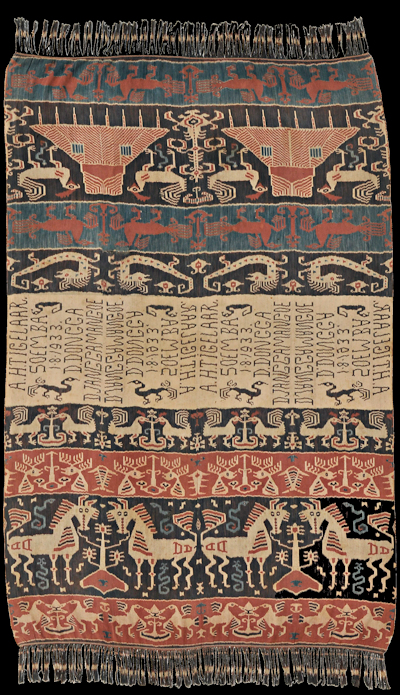| |
 
 | | | |
357 Sumba, East Sumba
Hinggi (men's blanket)
| | Locale: | Janga Mangu (Djangamangoe) | | Period: | 1933 | | Yarn: | Cotton, hand-spun, fine, double-ply | | Technique: | Warp ikat | | Panels: | 2 | | Size: | 146 x 234 cm (4' 9" x 7' 8") LW: 1.60 | | Weight: | 795 g (28.0 oz), 233 g/m2 (0.76 oz/ft2) | | Design: | This historic hinggi was a signed gift from the fearsome 'orang kaya' Umbu Dikki Dongga, the island's biggest horse trader, to the Dutch veterinarian A.H. Tigelaar, dated 1 August 1933, Djangamangoe. The cloth was created by Rambu Dai Ataluda (born 1905-1910) in her youth. The hinggi was made in pagi-soré style, i.e. with entirely different top and bottom decoration, meaning that there was no duplication along the cloth's horitontal axis, implying twice as much labour as on a standard hinggi. On Sumba this construction is known as searah, or satu arah, meaning 'one way, the whole length' - indicating what is ikated: the full length of the cloth. It stopped being made shortly after the time when this cloth was made, until a brief commercial revival in the 1970s and '80s. No element of the design is traditional. Whereas in some royal hinggi an adat house might be shown, what we see here are no doubt stables. Whose horses they would shelter is made clear by the brands on the horses' flanks: DD. | | Comment: | [PHOTOGRAPHY PROVISIONAL] Presumably this was Dikki Dongga's gift of gratitude to his veterinarian. It was not a cheap gift. Alhough machine-made yarn was readily available in 1933, this hinggi was was made with very fine hand-spun cotton. This explains its very low weight - which on Sumba, as nearly everywhere else in the archipelago, is associated with 'class' because it is always found in the company of complex design and very good execution. Rambu Dai Ataluda was a daughter of Dikki Dongga's first child, a daughter of his second wife whom Wielenga describes (1928:47) as renowned for her textile creations. The uniqueness of this early cloth lies in its indisputable dating and provenance. | | Background: | Chapters on Sumba and East Sumba. | | Published: | Ikat from Timor and its Outer Islands, 2022.
Noble Virtuosity: Hidden Asymmetry in Ikat from Sumba, 2024. | | Sources: | The missionary D.K. Wielenga in 1928 published a book about Dongga titled 'Oemboe Dongga, het kamponghoofd [the kepala kampung'] on Sumba'.in which he sketches the man's character. The Richardsons on their website (accessed 23 October 2020) make a hilarious mistake that reveals something about their 'scholarship'. They quote Wielenga as describing Dikki Donga's funeral, apparently not having noticed (because they cannot read Dutch but do like to cite early Dutch sources) that the funeral was not that of Dikki Dongga, but of his beloved consigliere and spokesman, for which he himself made the elaborate arrangements. Below is Wielenga's portrait of Dikki Dongga. He looks scrawny and unassuming, but was widely admired for his wealth - and feared for his ruthlessness.
 | | |

©Peter ten Hoopen, 2025
All rights reserved.
|
|


